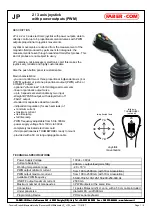
If a group has only one axis assigned to it, a linear motion of the
group is similar to moving that axis from one point to another.
Circular motion of a group with only one axis cannot be made.
If a group has more than two axes assigned to it, circular motion of
the group is made using the first two axes in the group.
The order in which axes are assigned to a group is very important.
This is because it specifies the frame of reference in which
coordinated motion of axes takes place. For instance, the command
1HN2, 3
assigns axis numbers 2 and 3 to group number 1, where axis
#2 is equivalent to X-axis and axis #3 is equivalent to Y-axis in a
traditional Cartesian coordinate system. Reversing the order of axes
(E.G.,
1HN3, 2
) reverses the axis assignment.
A few rules that are in place for easy management of group are as
follows:
•
An axis cannot be a member of different groups at the same time.
•
An axis cannot be assigned more than once in a group.
•
A group has to be deleted before axes assigned to it can be
changed.
•
An axis assigned to a group cannot be moved individually using
commands such as
PA
and
PR.
Use group linear move commands
instead.
Refer to the description of this command in the
commands section
(See Section 3: Remote Mode) for correct syntax, parameter ranges,
etc.
4.1.2.2 Defining Group Parameters
Group parameters such as velocity, acceleration, deceleration, jerk,
and e-stop deceleration must be defined for every group following the
creation of that group. These parameters are used to produce the
desired coordinated motion of the group. They override any original
values specified for individual axes. The axes' original values are
restored when the group to which they have been assigned is deleted.
Refer to the description of
HV, HA, HD, HJ,
and
HE
commands in
the
commands section
(See Section 3: Remote Mode) for correct
syntax, parameter ranges, etc.
4.1.3 Making Linear and Circular Moves
This subsection discusses the method for making linear and circular
moves of groups. While coordinated motion of axes with different
motor types and different encoder resolutions is supported, it is
assumed that all axes have the same units of measure.
4-2
Section
4
–
Advanced
Capabilities
Summary of Contents for ESP300 Series
Page 1: ...ESP300 Motion Controller Driver User s Manual...
Page 4: ...ESP300 1999 EU Declaration of Conformity iv Preface...
Page 29: ...This page is intentionally left blank Section 2 Modes of Operation 1 15...
Page 30: ......
Page 230: ...4 16 Section 4 Advanced Capabilities...
Page 274: ...This page is intentionally left blank 6 6 Section 6 Servo Tuning...
Page 290: ...This page is intentionally left blank B 6 Appendix B Trouble Shooting and Maintenance...
















































